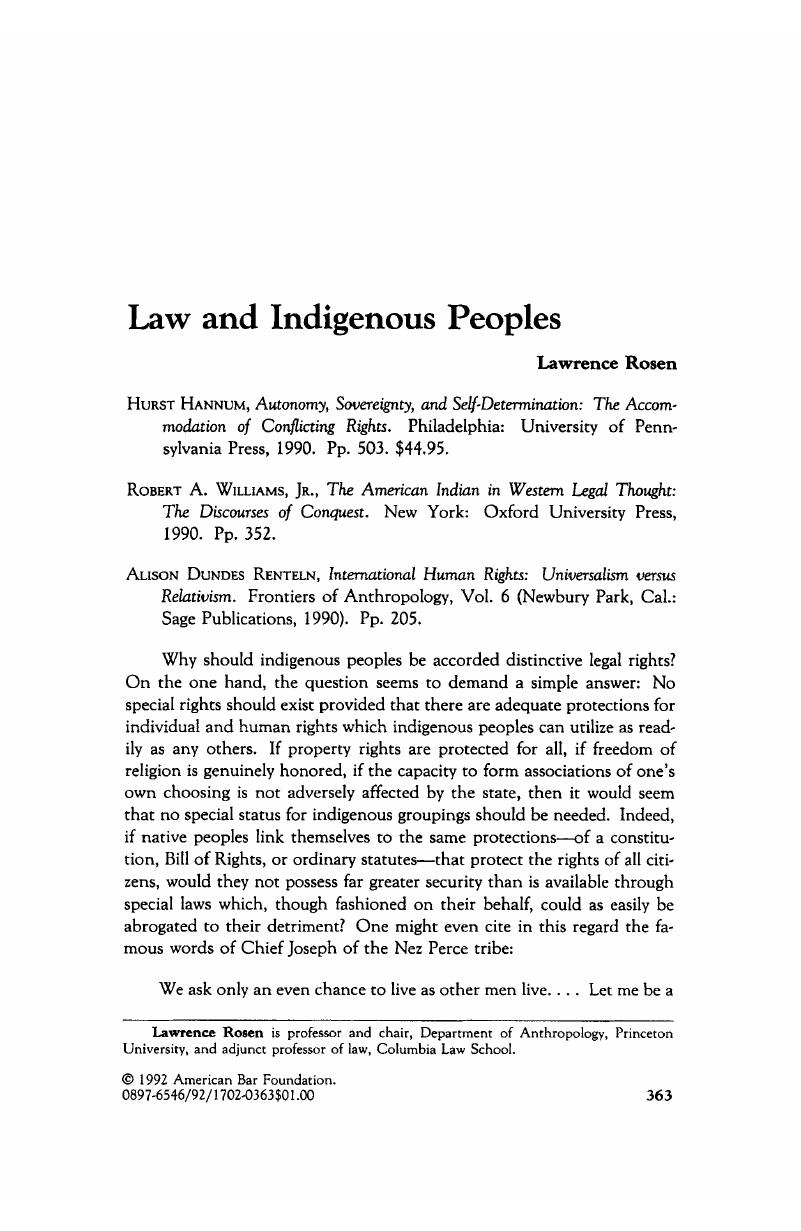No CrossRef data available.
Article contents
Law and Indigenous Peoples
Published online by Cambridge University Press: 27 December 2018
Abstract

- Type
- Review Essay
- Information
- Copyright
- Copyright © American Bar Foundation, 1992
References
1 In just such a case the U.S. Supreme Court decided that there was no jurisdiction in federal court for such a claim by an individual against her tribe. Santa Clara Pueblo v. Martinez, 436 U.S. 49. 98 S. Ct. 1670, 56 L. Ed. 2d 106 (1978). By comparison a Canadian commission found that it was a deprivation of her right of association with her tribe for an Indian woman to be denied continued membership in her group owing to a similar tribal membership rule enforceable by the Canadian government. The commission's decision was based on an interpretation of the International Covenant on Civil and Political Rights to which Canada was a signatory. Subsequent to the decision Canada changed its own laws on this matter to conform to the commission's ruling. Case of Sandra Lovelace, View of the Human Rights Committee under Article 5(4) of the Optional Protocol to the International Covenant on Civil and Political Rights Concerning Communication No. R 6/24 (1982).Google Scholar
2 For the US. position on this issue see United States v. Dion, 476 US. 734 (1986). and United States v. Billie, 667 F. Supp. 1485 (S.D. Ra. 1987).Google Scholar
3 For a collection of statements by indigenous people on their own rights, as well as background documents on a wide range of related issues, see Roger Moody, The Indigenous Voice: Visions and Realities, 2 vols. (London: Zed Books, 1988).Google Scholar
4 For other valuable assessments of the situation of indigenous peoples see Julian Burger, Report from the Frontier: The State of the World's Indigenous Peoples (London: Zed Books, 1987); John H. Bodley, Victim of Progress, 3d ed. (Mountain View, Cal.: Mayfield Publishing Co., 1990); Internationales Jahrbuch für Rechtsanthropologie, Law and Anthropology: The Aborigine in Comparative Law (Vienna: VWGO-Verlag, 1987); and the report of the Aga Khan's Commission, Indigenous Peoples: A Global Quest for Justice (London: Zed Books, 1987).Google Scholar
5 See, e.g., L. C. Green & Oliver P. Dickason, The Law of Nations and the New World (Edmonton: University of Alberta Press, 1989).Google Scholar
6 The Marshall triology is comprised of McIntosh, Johnson V., 21 U.S. (8 Wheat.) 543 (1823); Cherokee Nation V. Georgia, 30 U.S. (5 Pet.) 1 (1831); and Worcester v. Georgia, 31 US. (6 Pet.) 515 (1832).Google Scholar
7 Kent McNeil, Common Law Aboriginal Title (Oxford: Clarendon Press, 1989).Google Scholar
8 Among the best recent studies are Linda S. Parker, Native American Estate: The Struggle over Indian and Hawaiian Lands (Honolulu: University of Hawaii Press, 1989); Imre Sutton, ed., Irredeemable America: The Indians' Estate and Land Claims (Albuquerque: University of New Mexico Press, 1985); and Edwin N. Wilmsen, ed., We Are Here: Politics of Aboriginal Land Tenure (Berkeley: University of California Press, 1989).Google Scholar
9 For some additional approaches by anthropologists to issues of human rights across cultures see Theodore E. Downing & Gilbert Kushner, eds., Human Rights and Anthropology (Cambridge, Mass.: Cultural Survival, Inc., 1988).Google Scholar
10 See L. Swepston, “Indigenous and Tribal Peoples and International Law: Recent Developments,” 30 Current Anthropology 259 (1989); United Nations Economic and Social Council, Commission on Human Rights, Discrimination against Indigenous Peoples, E/CN.4/ Sub.2/1990/39 (1990); and Don Betz, “Persistent Peoples and International Organizations: Expanding Linkage in a Time of Rapid Global Change,”Sovereignty Symposium III: The Dialogue Continues (Oklahoma City: Oklahoma Supreme Court, 1990).Google Scholar
11 US. House of Representatives, A Bill to Protect Indigenous Peoples Throughout the World, H.R. 879, 101st Cong., 1st sess. (1990).Google Scholar
12 See my discussion in Rosen, Lawrence, “Individualism, Community, and the Law,” 55 U. Chi. L. Rev 571 (1988).CrossRefGoogle Scholar




